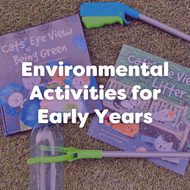Environmental Activities for Early Years
Posted by EYR Team on 23rd Oct 2023
read more
The world we live in is facing more and more environmental challenges. Therefore, it is important, now more than ever, to educate the next generation, giving them an increased sense of responsibility and awareness for the environment. Introducing environmental awareness and an understanding of the world to children in the early years can build this foundation of understanding. Environmental activities can be used to help teach children more about the world around them, develop a love and appreciation for nature and in turn, promote a sustainable future. In this blog, we'll explore a selection of enjoyable and educational Environmental Activities for Early Years. These tips and activities are not only easy to start with but also effective in nurturing an early awareness about the environment in your young ones.
Simple changes to introduce
- Getting outdoors! Whether this is simply playing in the garden or going on a nature walk, it is a great first step in getting children familiar with the world around them and sparking conversations about the environment.
- Recycling! Again another simple step that you most likely already do but might not engage your little ones in. This doesn’t have to be sitting with them to divide up your household waste into recycling. (Although this could be a fun sorting game!) But instead, show your little ones how items can be reused and upcycled and why this is important.
- Reading. Whilst this might already be part of your routine with your little ones, a small change in the books you read with them can make a huge difference in their understanding of the world. This could be books about animals in which you could spark discussions about threats to extinction, or even more educational books about recycling!
5 Environmental Activity Ideas to try in your setting:
1. Create your own eco garden

Your garden can be made entirely dependent on the materials you have available and the size of your space. It can also be flexible and adapted easily! Creating your own garden can offer the following benefits:
- Children will learn more about plants and wildlife
- Children will develop a sense of responsibility for the crops they plant
- Your little ones will have the opportunity to live sustainably and eat the crops they have grown
Atop of this, making sure the garden is eco-friendly teaches children how the same result can be achieved with upcycled and recycled materials. Ways in which to create an eco-garden include: - Collecting rainwater to water plants
- Creating compost from household waste such as apple cores and egg shells
- Using items such as old tyres, shoes and water bottles to plant crops
2. Recycled boats - STEAM project
Creating masterpieces from old resources is always a great way to teach children about sustainability and recycling. Why not add a STEAM element into the mix and task your little ones with creating a boat that floats using items that would have ordinarily gone into the bin?

3. Beach Clean-Up Tuff Tray

Bring the outside in! Whilst getting outdoors is a great way to teach children about the world around them, that isn’t to say the same lessons can’t be taught on a smaller scale indoors. Why not replicate our beach clean-up tuff tray and teach your little ones all about conservation and protection of our beaches.
Task children with using the tongs and tweezers to collect the “rubbish” floating in the oceans and on the beach. You could elevate this by adding sea creatures to the water to spark discussions around the impact this has on our animals.
4. Litter Picking
Litter picking is a great way to increase your little one’s environmental awareness. Children will have a real appreciation for the planet and how to protect it when they are out and about observing the amount of litter than can be amongst nature. Not only this, but litter picking is an ideal activity to develop both fine and gross motor skills. Manipulating the littler picker requires children to exercise the small muscles in their hands and manoeuvring it requires hand eye coordination and arm muscles.
Why not turn this into a game? Task children with finding litter of certain colours or shapes to make the activity more challenging and memorable.

5. Build Sustainable Habitats

Inviting living things into your green spaces and play areas provides children with endless opportunities to investigate and observe natural life. This in turn promotes a sense of respect and care for the environment.
Once again using recycled and natural materials are key! This makes this activity incredibly easy to do and requires your children to think creatively, evaluating the needs of the animal and responding to this with selected materials to create a cosy habitat.

